Tenkara, the traditional Japanese method of fixed line fly fishing for small fish in high mountain streams is slowly but surely becoming Americanized. Whether we like it or not. These days, the hottest tenkara topic on social media venues is around, “big fish”. Some might say it diminishes the method’s origin. Others will profess it’s part of the natural, evolutionary progression of any sport. Whatever your opinion on the subject, many anglers are interested and want to understand how to land bigger fish, powerful fish, without a reel. That’s what I aim to cover in this article.
I started down this path not only as part of my own fly-fishing journey but also because of a challenge directed at me more than 10 years ago. I will never forget when a fly shop owner tried to provoke me with a dare, “Go catch a bonefish on that thing, then come back and talk to me.” That was all it took. I had never saltwater fished in my life. Certainly, I had seen photos of bonefish and read about them. I knew they were admired for their power and speed. The whole saltwater thing seemed like a step up from my usual trout fishing. Heck, I wasn’t sure I could land a bonefish on a reel, let alone on a tenkara rod. I decided the only way to find out was to try, and so I did.
On that first of many saltwater trips to come, I did not land a bonefish on my tenkara rod. To my surprise, I did land a tarpon, several sharks, some snappers along with a few other species. Fast forward several years and by this time, I had landed plenty of bonefish on a fixed line – more than 100. I had also landed barracudas, junior permit, many tarpon and tons of jacks. In freshwater, carp on a tenkara rod have been one of my favorites since 2013 and without hesitation I do char, grayling, sockeye, coho and king salmon along with the big rainbows up in Alaska. All on a fixed line. I’m listing these catches not to boast or to iterate, but rather to demonstrate that landing these big, powerful fish on a tenkara rod isn’t just a fluke or luck. It takes skill and understanding and yes, a capable rod. But logically explaining when asked, how I hold and land these fish when they run, baffled me.
Then, one day while editing some tenkara video footage, it came to me. I had a true epiphany. In video after video and photo after photo I kept seeing triangles. It occurred to me that every time I hooked a fish, a triad relationship was born. Me, the fish, and the rod tip created the three points of a triangle. As the fish moved, I moved, or the rod tip moved the type of triangle we created changed. More specifically, the angles between these three points changed. The triangle was ever present.

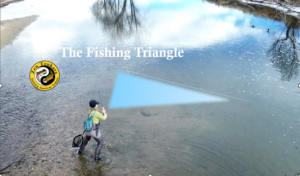
As I watched the videos, I had a unique advantage of observing myself and the rod, while simultaneously replaying the entire event in my mind. Reliving each moment so to speak, while I watched. In no time it because obvious that the type of triangle formed by my position, and to a greater degree, the rod’s position in reference to where the fish was moving, not just influenced but determined, the amount of control I had over the fish at any given moment during the fight.
This theory that, when in a right fishing triangle (a 90º angle between the fish and the rod tip) life was good, was evident in both fresh and saltwater. Where my rod tip was, in reference to the fish and the direction it was moving, consistently dictated success or failure. Pouring through even more videos and pictures only confirmed this triangle was the primary predictor for whether a fish would be landed. I wondered if these same fundamentals also applied when fishing with a reel.
On a traditional western setup (rod and reel), when we set on a fish our rod tip is usually at about a 90º angle. Even with a strip set we immediately lift the rod. As the fish fights and then runs, we lower the rod to allow the fish to take line. As the rod is lowered, the angle between the fish and the tip is reduced. When a fish runs, the angler isn’t really in control. He or she is simply holding on and relying on the fish to create tension and the reel’s drag system to tire the fish while staying connected. It’s a bit of a Hail Mary.
When the fish is tired and pauses, the angler cranks the reel and takes up line. As he does this, he gradually begins to raise the rod up, trying to increase the angle between tip and fish to re-establish that 90º triangle and thereby regain control. If the fish runs again, the tip is once more lowered, the angle reduced, and the fisherman holds on. This pattern of running and reeling line, losing and regaining control, opening and closing the angle between fish and rod tip, happens repeatedly until the fish is landed.
When we look at the above diagrams, the green lines represent the “Zone of Control”. It ranges from about 50º to about 120º. When the rod is in this area you’re generally in control of things. Move the rod beyond the green lines into the yellow or worse, orange area, and things get dicey. If the angler doesn’t make a correction quickly, things will go south fast. If the rod moves into the red area, the fish is in a full run and as we mentioned earlier, the drag system engages, the fish takes line and the angler just holds on.
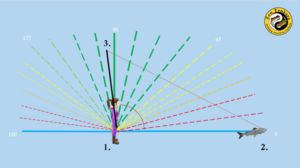
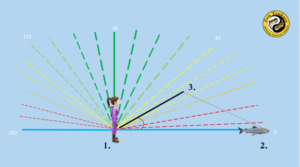
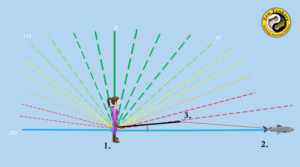
On a tenkara rod, the red lines mean game over. There’s no extra line for the fish to take on a fixed setup. You don’t have the luxury of “holding on” until the fish pauses. So how do we stay in control and keep the fish from running? The key is in the triangle. Maintaining about 90º between the fish and the rod tip is essential. But there’s more. The plane along which you fight the fish will also impact your success.
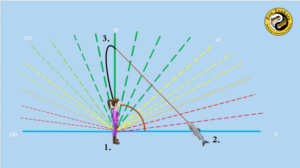
In the above diagram the angler has established a right triangle. We see approximately 90º between fish and rod tip. However, in this vertical position with a tenkara rod, too much pressure is placed on the top sections. The likelihood of a break occurring or the fish throwing the hook from this position is massive. The angler is trying to play and control the fish with the softest and flexiest portion of her rod. She isn’t using the rod’s backbone and she has little chance of guiding or steering the fish with the rod in this position – even though she has established a 90º angle, of course unless the fish is very small. But we’re focusing here on BIG FISH.
As the fish struggles on the tenkara rod the tip will bend and bounce. This uneven tension creates moments of slack in the line. Attempting to land a bigger fish with the rod held up high commonly ends in one of three different mishaps: 1) the uneven tension and slack in the line will allow the fish to throw the hook; 2) the soft tip section bounces causing uneven pressure on the tippet and the tippet will break or; 3) the bounce and fluctuating load from playing the fish with the softest most delicate part of the rod will overload these fine sections and the rod will break.
Additionally, in this vertical position the fish has a 360º playing field and quite literally can run circles around you. Get into a more effective power curve position and reduce the playing field from 360º to 180º by simply laying the rod over to the side. Avoid turning your rod into a candy cane shape and aim instead for the letter “C” held at about 45º to 65º off the surface of the water. When the rod is held in this position, the pressure is more evenly distributed along the length of the rod. This allows you to engage the entire rod and draw strength from the beefier lower sections. Playing to the side gives you more power to steer and guide fish and it’s easier to maintain the fishing triangle – those 90º from fish to rod tip, that keeps you in the green Zone of Control.
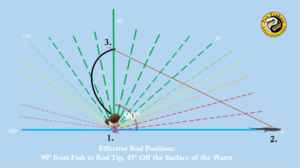
If the fish is allowed to run or is simply powerful enough to force the run, then the angle between your rod tip and the fish will begin to decrease even while your rod is being held at 45º off the surface of the water. Pay attention here. Remember, there are 2 different angles at work: the angle between the fish and your rod tip (which is part of the Fishing Triangle) AND, the angle at which you hold your rod off the surface of the water. As a reference, if you held your rod straight up in the air, that would be 90º off the surface of the water. If you held your rod parallel to the surface of the water, that would be 180º. The goal is to position your rod in between these two reference points, at 45º. This position is critical because it encourages the angler to distribute the load more evenly along the length of the rod and keeps the fight out of the tip sections.
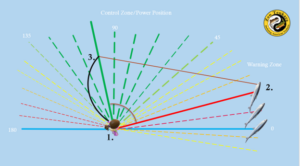
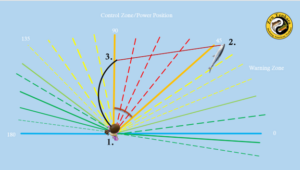
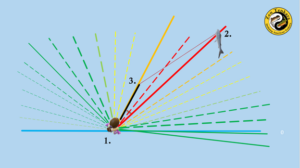
As the fish runs, the angle between the rod tip and the fish is reduced. The Zone of Control, those green lines, move as the fish moves. The angler is losing control, her rod is straightening, and the angle is decreasing. She needs to quickly re-establish that 90º Fishing Triangle while keeping her rod 45º off the surface of the water and to the side.
This is accomplished in one of two ways – or if desperate, by combining the two: 1) Flip the rod to the opposite side – opposite the direction the fish is moving. When we flip the rod “opposite the fish” we re-create our right triangle on the other side and reposition ourselves back into a Zone of Control. It is crucial to flip the rod in a smooth fashion to maintain consistent and even pressure on the fish during this motion. You’re most vulnerable when your rod is overhead. Don’t spend any unnecessary time with your rod up high. Remember, when your rod is up top more pressure is placed on the tip sections. Don’t rush it either. Just lay your rod over to the opposite side in one smooth, swift movement and keep steady pressure on the fish so it can’t run and won’t throw the hook.
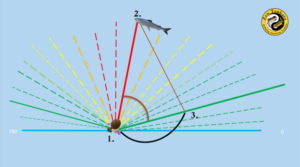
The second alternative takes muscle both on the part of the angler and the tenkara rod: 2) MOVE! Quickly. If you don’t flip the rod (which essentially applies pressure to the fish’s head and turns it), your only other option for re-establishing that 90º Fishing Triangle is to move. You are the third point of the fishing triangle. If you move by advancing forward, while simultaneously pulling your rod back (this doubles the effort and distance gained) you can get back into that 90º angle – between fish and rod tip. It’s a last-ditch effort, a “move” of desperation, but often works.
Even better, don’t let yourself come out of the fishing triangle, ever. Maintaining those 90º degrees between your rod tip and the fish should always be your primary goal. In doing so, the fish never gets the opportunity to run. You control the fish’s head, and you control the fish’s body. Do this while keeping your rod about 45º to 65º degrees off the surface of the water to make certain you are drawing strength from the whole rod, and not inadvertently playing the fish on the tip. Following these simple strategies will almost guarantee you’ll land the fish. In other words, forget the fish and focus on the triangle. This will ultimately lead to more success.
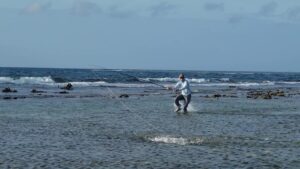
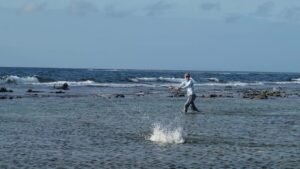
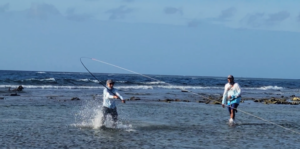
Lastly, this is nothing new. “Point the rod opposite the fish,” is something that guides instruct us to do all the time. But they don’t tell us why. Maybe it’s because they don’t really understand the dynamics behind the move. Instinctually or from experience, they just know it works. This is fish management at its most basic. It’s applicable in freshwater, saltwater, on a reel or off a reel. It is the very same method for turning a running fish on a reel, when there is an obstacle in the river downstream and you need to keep the fish from reaching it. You stop line from coming off your reel, use the fish’s momentum to turn it, and hold the fish steady by pointing the rod in the opposite direction it is trying to move towards.
Nowadays when a western fly angler asks me what I do when a fish runs since I don’t have a reel, I turn it around and ask them, what do they do, when they can’t let a fish run. Manage it. Big fish on tenkara are fun. It’s thrilling and intense. It requires thoughtfulness and awareness. It is tactile, electrifying, and fast. You respond and react in microseconds, all while the world stands still, and is quiet. It is satisfying and incredibly rewarding, I darn say even more so, than landing fish with a reel – simply because you cannot afford to make an error. The tiniest of mistakes are rarely overcome. You don’t have a reel to fall back on and simply hold on. When you land a large fish, a strong, powerful fish on a tenkara rod, you know it all came together. You did it right. Mano a mano. The sense of accomplishment is incredible.
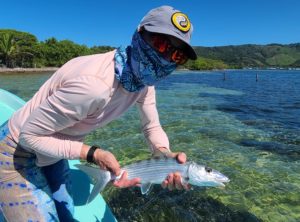


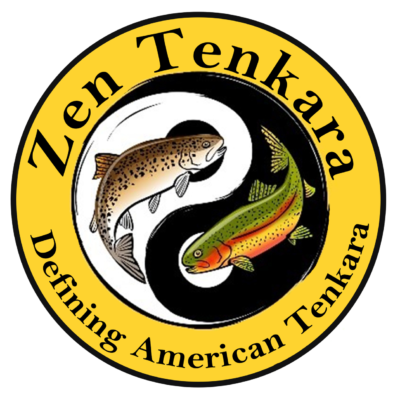

Karin,
This tremendous blog article, combined with listening to a podcast you were on talking about big fish is a game changer for me.